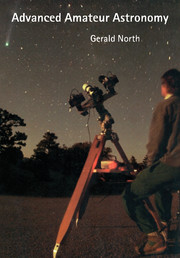Book contents
- Frontmatter
- Contents
- Preface to the second edition
- Preface to the first edition
- Acknowledgements
- 1 Telescope optics
- 2 Atmosphere, seeing, magnification and eyepieces
- 3 Telescope hardware and adjustments
- 4 Astrophotography with the camera
- 5 Astrophotography through the telescope
- 6 Electronic imaging
- 7 The Moon
- 8 The terrestrial planets
- 9 The gas-giant planets
- 10 Asteroids, comets, meteors and aurorae
- 11 The Sun
- 12 Variable stars and novae
- 13 Methods of photometry
- 14 Double stars, star clusters, nebulae, galaxies and supernovae
- 15 Spectroscopy
- 16 Radio astronomy
- 17 Further information
- Appendix: Useful formulae
- Index
13 - Methods of photometry
Published online by Cambridge University Press: 04 August 2010
- Frontmatter
- Contents
- Preface to the second edition
- Preface to the first edition
- Acknowledgements
- 1 Telescope optics
- 2 Atmosphere, seeing, magnification and eyepieces
- 3 Telescope hardware and adjustments
- 4 Astrophotography with the camera
- 5 Astrophotography through the telescope
- 6 Electronic imaging
- 7 The Moon
- 8 The terrestrial planets
- 9 The gas-giant planets
- 10 Asteroids, comets, meteors and aurorae
- 11 The Sun
- 12 Variable stars and novae
- 13 Methods of photometry
- 14 Double stars, star clusters, nebulae, galaxies and supernovae
- 15 Spectroscopy
- 16 Radio astronomy
- 17 Further information
- Appendix: Useful formulae
- Index
Summary
This chapter, building on the last, extends to methods of quantitatively measuring the brightnesses of celestial bodies, rather than relying on eye-estimates alone.
Artificial star photometer
The general principle and construction of this device is illustrated in Figure 13.1. The idea is that an artificial star is created in part of the field of view of the telescope eyepiece. The real star is brought to a position nearby and the brightness of the artificial star is adjusted until it matches the real star. The eye is better at matching brightnesses than it is at gauging brightness differences.
In practice the bulb changes its colour together with its brightness. In any case, this colour might well be different to that of the star and so cause difficulties when making the comparison. Using a strong yellow filter to unify both the artificial star and the real star overcomes this problem.
Another difficulty is that the artificial star may look significantly different in size and brightness distribution to the real star. Defocusing the eyepiece slightly may help. The two small discs should now look much more similar. I haven't included the mechanical arrangement for the provision for altering the focus of the eyepiece in the diagram, for the sake of simplicity. A small rackmount, or a helical focuser, or a simple sliding tube should do the job.
If you use a 6V 3W bulb it will draw a current of 0.5 A and have a resistance of 12Ω when run normally.
- Type
- Chapter
- Information
- Advanced Amateur Astronomy , pp. 292 - 313Publisher: Cambridge University PressPrint publication year: 1997



